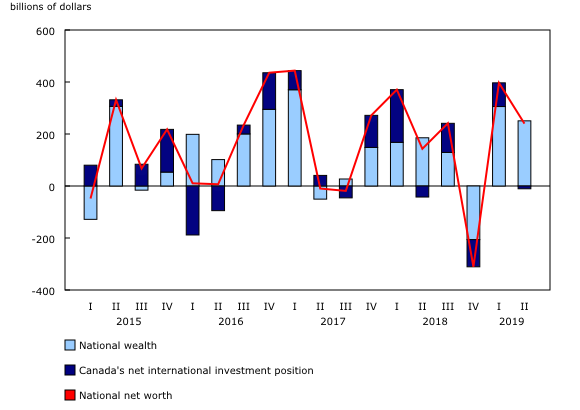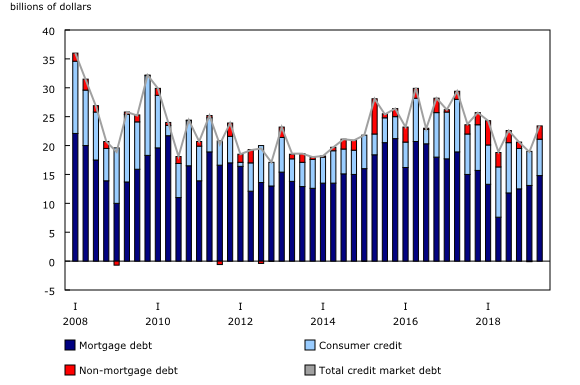National balance sheet and financial flow accounts, second quarter 2019
Archived Content
Information identified as archived is provided for reference, research or recordkeeping purposes. It is not subject to the Government of Canada Web Standards and has not been altered or updated since it was archived. Please "contact us" to request a format other than those available.
Released: 2019-09-13
National wealth continues to increase as energy prices strengthen
National wealth, the value of non-financial assets in the Canadian economy, rose 2.2% to $11,694.5 billion in the second quarter. This was due primarily to sustained growth in the value of natural resources, which increased 16.8%, the second consecutive quarter of strong growth, as oil prices continued to increase. Residential real estate also contributed to the increase, rising 0.9%. National wealth has been increasing since the third quarter of 2017, with the exception of the fourth quarter of 2018, when the value of both natural resources and financial assets fell.
Canada's net foreign asset position decreased by $10.7 billion in the second quarter to $689.7 billion, as the growth in international liabilities exceeded the growth in international assets. The decline mostly reflected net changes in positions resulting from downward revaluations due to the appreciation of the Canadian dollar.
National net worth, the sum of national wealth and Canada's net foreign asset position, increased 2.0% to $12,384.2 billion in the second quarter. This increase was due primarily to the growth in non-financial assets. On a per capita basis, national net worth rose from $324,602 to $329,508.
Household net worth increases for the second consecutive quarter
The household sector's net worth rose 1.2% to $11,261.5 billion in the second quarter. This was partly the result of a 1.1% increase in the value of non-financial assets. Residential real estate grew 0.9% during the period, the second consecutive quarterly increase following two consecutive quarterly declines in the latter half of 2018.
Financial assets rose 1.5% in the second quarter after growing 3.8% in the previous quarter, as domestic and foreign equity markets posted modest growth.
Financial liabilities rose 1.6%, the largest quarterly increase since the second quarter of 2017, as mortgage debt (+1.4%) and consumer credit and non-mortgage debt (+1.9%) grew. Consequently, the debt-to-asset ratio increased to 16.9%.
Seasonally adjusted household borrowing rises
On a seasonally adjusted basis, total credit market borrowing increased to $23.5 billion from $18.9 billion in the previous quarter. Demand for consumer credit and non-mortgage loans rose to $8.6 billion, while mortgage borrowing was $14.8 billion.
Credit market debt (consumer credit, and mortgage and non-mortgage loans) totalled $2,251.7 billion in the second quarter. Mortgage debt totalled $1,468.8 billion, while consumer credit and non-mortgage loans stood at $782.9 billion.
The household debt service ratio, measured as total obligated payments of principal and interest on credit market debt as a proportion of household disposable income, edged up to 14.93% in the second quarter, as growth in total obligated debt payments (+1.8%) slightly outpaced growth in disposable income (+1.4%). As a result of higher interest costs, the gap between mortgage interest payments and mortgage principal payments continued to widen, a trend that began in 2017.
Household credit market debt as a proportion of household disposable income fell to 177.1%, the third consecutive quarterly decline, as income grew slightly faster than debt. In other words, there was $1.77 in credit market debt for every dollar of household disposable income. Since the third quarter of 2018, household disposable income has increased 3.4%, while household credit market debt has grown 2.8%.
Federal government net debt to gross domestic product improves for the second consecutive quarter
The federal government demand for credit market debt was $3.8 billion in the second quarter, led by $3.9 billion in net issuances of bonds.
The demand for funds by other levels of government totalled $6.7 billion in the second quarter. This was led by net issuances of bonds and debentures (+$3.5 billion) and short-term paper (+$2.2 billion).
The ratio of federal government net debt (book value) to gross domestic product (GDP) improved to 26.2% in the second quarter, as growth in GDP outpaced the growth in federal government net debt. The ratio of other government net debt excluding social security funds (book value) to GDP surpassed the ratio of federal government net debt to GDP for the third consecutive quarter, edging up to 27.7%.
Demand for funds by non-financial private corporations continues to slow
The demand for funds by non-financial private corporations was $15.5 billion in the second quarter, down from $34.3 billion in the previous quarter. The bulk of financing in the second quarter was in the form of non-mortgage loans (+$28.8 billion).
Non-financial private corporations' debt-to-equity ratio (book value) edged down in the second quarter, to 67.7%.
Financial sector mortgage lending rebounds
The financial sector provided $48.7 billion in funds to the economy through financial market instruments in the second quarter, up from $31.8 billion in the previous quarter. Second quarter financing was attributable mainly to non-mortgage (+$24.1 billion) and mortgage (+$22.7 billion) loans.
Among financial corporations, the market value of financial assets rose $238.9 billion in the second quarter to $14,699.4 billion. This was due primarily to increased financing and other transactions in the amount of $148.8 billion, led by loans and equity. Upward revaluations and other volume changes in the amount of $90.1 billion, mainly in equity investment, also contributed to the higher value of financial assets in the quarter. In the household sector, the value of financial assets increased by $102.5 billion, benefiting from upward revaluations in mutual funds and life insurance and pensions.
Additional financial subsectors
New financial subsector detail will be published with the release of third-quarter 2019 data. The current subsector "Other private financial institutions" will be broken down into additional financial subsectors and will more closely align with current international classifications.
Note to readers
Revisions
This second quarter release of the national balance sheet and financial flow accounts includes revised data for the first quarter of 2019. These data incorporate new and revised data, as well as updated data on seasonal trends.
In the near future, data enhancements to the national balance sheet and financial flow accounts, such as the development of detailed counterparty information by sector, will be incorporated. To facilitate this initiative and others, it is necessary to extend the annual revision period (normally the previous three years) at the time of the third-quarter release. Consequently, for the next two years, with the third-quarter release of the financial and wealth accounts, data will be revised back to 1990 to ensure a continuous time series.
Financial and wealth accounts on a from-whom-to-whom basis: Selected financial instruments
The data visualization product "Financial accounts on a from-whom-to-whom basis, selected financial instruments" has been updated with data from the first and second quarters of 2019.
Next release
Data on the national balance sheet and financial flow accounts for the third quarter will be released on December 13.
Overview of the Financial and Wealth Accounts
This release of the Financial and Wealth Accounts comprises the National Balance Sheet Accounts (NBSA), the Financial Flow Accounts (FFA), and the other changes in assets account.
The NBSA are composed of the balance sheets of all sectors and subsectors of the economy. The main sectors are households, non-profit institutions serving households, financial corporations, non-financial corporations, government and non-residents. The NBSA cover all national non-financial assets and all financial asset-liability claims outstanding in all sectors. To improve the interpretability of financial flows data, selected household borrowing series are available on a seasonally adjusted basis (table 38-10-0238-01). All other data are unadjusted for seasonal variation. For information on seasonal adjustment, see Seasonally adjusted data – Frequently asked questions.
The FFA articulate net lending or borrowing activity by sector by measuring financial transactions in the economy. The FFA arrive at a measure of net financial investment, which is the difference between transactions in financial assets and liabilities (for example, net purchases of securities less net issuances of securities). The FFA also provide the link between financial and non-financial activity in the economy, which ties estimates of saving and non-financial capital acquisition (for example, investment in new housing) to the underlying financial transactions.
While the FFA record changes in financial assets and liabilities between opening and closing balance sheets that are associated with transactions during the accounting period, the value of assets and liabilities held by an institution can also change for other reasons. These other types of changes, referred to as other economic flows, are recorded in the other changes in assets account.
There are two main components to this account. One is the other changes in the volume of assets account. This account includes changes in non-financial and financial assets and liabilities relating to the economic appearance and disappearance of assets, the effects of external events such as wars or catastrophes on the value of assets, and changes in the classification and structure of assets. The other main component is the revaluation account, showing holding gains or losses accruing to the owners of non-financial and financial assets and liabilities during the accounting period as a result of changes in market price valuations.
At present, only the aggregate other change in assets are available within the Canadian System of Macroeconomic Accounts; no details are available on the different components.
Definitions concerning financial indicators can be found in Financial indicators from the National Balance Sheet Accounts and in the Canadian System of Macroeconomic Accounts glossary.
Products
The data visualization product "Financial accounts on a from-whom-to-whom basis, selected financial instruments," part of Statistics Canada— Data Visualization Products (71-607-X), is now available.
The Latest Developments in the Canadian Economic Accounts (13-605-X) is available.
The User Guide: Canadian System of Macroeconomic Accounts (13-606-G) is available.
The Methodological Guide: Canadian System of Macroeconomic Accounts (13-607-X) is available.
Contact information
For more information, or to enquire about the concepts, methods or data quality of this release, contact us (toll-free 1-800-263-1136; 514-283-8300; STATCAN.infostats-infostats.STATCAN@canada.ca) or Media Relations (613-951-4636; STATCAN.mediahotline-ligneinfomedias.STATCAN@canada.ca).
- Date modified:








